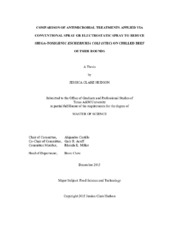| dc.description.abstract | The purpose of this study was to compare the efficacy of different antimicrobial interventions: lactic acid, lauric arginate ester, cetylpyridinium chloride or peracetic acid applied with either conventional spray or hand-held electrostatic spray to reduce populations of Shiga-toxin producing Escherichia coli (STEC).
Hot-boned beef outside rounds were inoculated within 1 hour after harvest with a cocktail of 8 serotypes of Shiga-toxigenic E. coli (STEC8). Outside rounds were chilled upon transport back to Texas A&M University, and then hung on flame-sterilized meat hooks at 4°C for 36 hours to simulate a contaminated full carcass side in the chiller. Then, outside rounds were treated with lactic acid, lauric arginate ester, cetylpyridinium chloride, peracetic acid, or water (control) using conventional spray or electrostatic spray. Pre-treatment and post-treatment samples were excised from all rounds to evaluate the efficacy of all interventions and the mode with which they were applied.
Lactic acid applied with conventional spray achieved the greatest reduction of
STEC8 populations compared to all other treatments. In most cases, reductions obtained by conventional spray and electrostatic spray were not significantly different. The only treatment that differed significantly between conventional spray and electrostatic spray was lactic acid. Among the treatments applied with electrostatic spray, lauric arginate ester produced the greatest reduction of STEC8. If carcass interventions have similar performance between conventional and electrostatic spray, the use of the electrostaticspraying system would be advantageous by saving water and antimicrobial. Spray type and intervention must be paired appropriately for optimum beef safety. | en |


